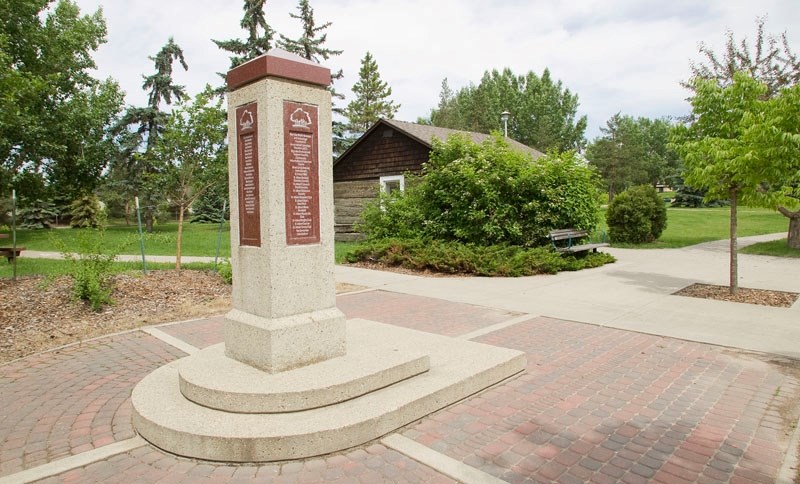A select few trailblazers had their names set in stone this week as city staff unveiled a new monument to their work on the Red Willow Trail.
About 70 people gathered by the obelisk near Sturgeon Road and St. Albert Trail Saturday morning to honour 42 groups and individuals who contributed to the construction of Red Willow Trail. The ceremony was part of a new program meant to recognize people who contribute to the Red Willow Park system.
The obelisk was originally intended to honour those who made large cash donations to the park system, said city manager Bill Holtby, but that never really caught on. As a result, the obelisk has remained blank for about 15 years.
Mayor Nolan Crouse says he noticed the obelisk while cycling and suggested it be used to honour those who built the trail system. "It's a piece of our history that needs to be captured," he says of the trail, and here was a piece of public art that wasn't being used. This was a way to put the city's history on display.
The obelisk features the names of 20 organizations and 22 people who either worked on or donated to the trail's construction, says city community recreation co-ordinator Micah Seon-King. Among the names are many current and former city employees such as Kevin Veenstra, John Beedle and Roger Belley. At Crouse's request, it does not include any politicians.
The road to the trail
Work on the Red Willow Trail actually started back in the 1980s, says Holtby, a long-time city employee and one of the people named on the obelisk. The province had given cities tens of millions in funding in the 1970s to develop urban parks, he notes, but St. Albert had been shut out, as it had been on the verge of annexation by Edmonton at the time. "The city lobbied very, very hard to get some money from the provincial government," he said, and started working on plans for an urban park.
Community consultation revealed a great desire for an urban trail system, say Margaret and Richard Plain, who had close ties to council at the time. Around 1984, the city received a grant from the Devonian Foundation to build a trail along the Sturgeon River. This trail stretched from St. Albert Place to the trestle bridge and consisted of two sidewalks with trees between them.
The city received $11 million to develop a plan for Red Willow Park in around 1989, Holtby says. That plan featured many elements that are now reality today, such as Rotary Park, and others that are not, such as the golf course by the Kinsmen Banquet Centre. "The trail system was integral to it all."
Reached by phone in B.C., former Red Willow Park foreman Roger Belley recalls taking architects through forests and ravines during the park's design process. "One of the most exciting things was the Red Willow symbol," he says, which was originally far more complex than it is now. "It looked like flowing hair on one side."
Crews dismantled the double-sidewalk trail and laid down asphalt, initially by city hall and other urbanized areas. "When we started construction on the other side of the trestle [bridge]," Belley says, "it really opened up all the natural areas of our community."
His first trip down the trail in Braeside ravine was something to behold. "You couldn't hear any traffic. You felt like you could be anywhere."
The project was not without controversy, he continues, and often ran up against NIMBYism. "We had to learn everything from scratch," as staff had never built or maintained a trail system before. Work with police and Citizens On Patrol groups helped reassure people the trails would not ruin their lives. "In many ways, it brought the community closer together."
Countless city residents now walk, skate and bike on the trail every day, Crouse says. "It's the most cost effective recreational system we have."
This was an exceptional act of recognition by the city, Holtby says, one public servants don't usually receive. "It makes you proud to be an employee of the City of St. Albert and a citizen of the city."
The city will add more trail contributors to the monument next year, Seon-King says.




